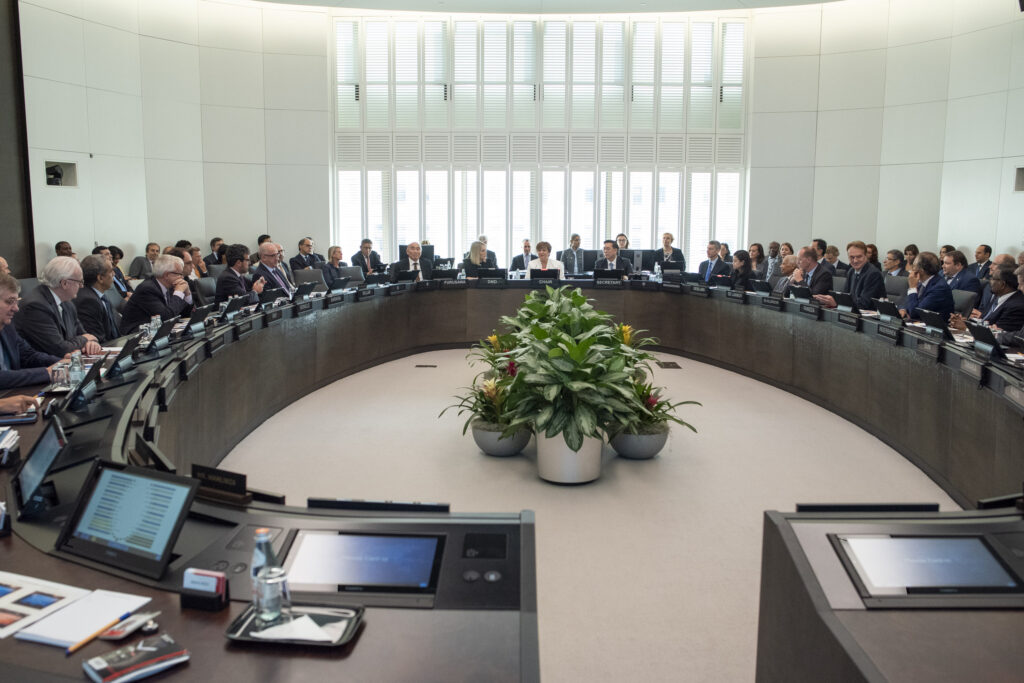This article first appeared in June’s print edition of Business Monthly.
For Egypt, the IMF is more than a lender offering support after the exodus of foreign investors. “Staff-level agreements reached with the IMF are [like] an international certificate asserting the economy’s strength and resilience and the success of the government’s reform program,” Parliamentarian Ahmed Abaza said at a hearing in March.
The latest agreement was in April, days after Egypt secured a commitment of $35 billion from the Abu Dhabi Developmental Holding Co. for the Ras El Hikma triangle. The staff-level agreement saw the IMF increase the $3 billion Extended Fund Facility (EFF), which it approved in 2022, by about $5 billion, also to be paid in tranches after periodic reviews until 2026.
“Recent measures toward correcting macroeconomic imbalances, including the unification of the exchange rate, clearance of the foreign exchange demand backlog, and significant tightening of monetary and fiscal policies were difficult but critical steps forward,” said Kristalina Georgieva, IMF managing director, and chair, in an April press release. “The authorities’ policies are well calibrated to entrench macroeconomic stability while protecting the vulnerable.”
However, Egypt does face some risks. “Externally, uncertainty remains high,” said Georgieva. “Domestically, sustaining the shift to a liberalized foreign exchange system, maintaining tight monetary and fiscal policies, and integrating transparently off-budget investment … will be critical.”
Additionally, how the government manages the inflow of dollars to contain inflation and limit the risk of future external pressures will be vital, she added.
Achievements
The report accompanying the IMF’s April press release said Egypt had a “mixed” start to fiscal year (FY) 2023/2024.
On the plus side, the government has achieved a 2.5% of GDP primary budget surplus, where government revenue is higher than its spending before paying the debt installment, the IMF report said.
Another upside is that the state hasn’t accumulated external arrears, has somewhat relaxed currency exchange restrictions, no longer has multiple exchange rates thanks to a “flexible exchange rate regime,” and is gradually reducing import restrictions.
The report also praised the Central Bank (CBE) for significantly increasing interest rates from 21.25% to 27.25% in April to limit post-float inflation.
The IMF also commended the Finance Ministry for “overperforming on their indicative target on tax revenue and social spending” by the end of FY 2022/2023.
The report also approved the state’s decision to end “the required use of Letters of Credit [as] an instrument for rationing import demand.” The other positive is publishing the State Ownership Policy document as a roadmap for divesting state-owned firms.
The IMF also highlighted the positives from “amended aspects of the competition law governing mergers and acquisitions.” However, the report said the legislature needs to approve the executive regulation document to fully benefit from its reforms.
Other positive points include “expanding the number of households eligible for social assistance, identifying tax policy measures for the FY 2023/2024 budget, abstaining from granting exemptions for commercial banks, [and] refraining from introducing subsidized lending [via] CBE.”
Ultimately, those efforts should create solid buffers for the economy. “Tightening of monetary and fiscal policies, implementation of planned divestments, and program financing [will] ensure the future [net international reserves] targets remain achievable.”
Off the mark
By the end of FY 2022/2023, the IMF said, the government had missed its targets to reduce debt and reach more favorable maturity dates for “new domestic debt issuances … due to the skewing of issuances to short-term bills and notes as authorities sought … to prevent locking-in high interest rates.”
The state also failed to “publish all public procurement contracts that exceed EGP 20 million on the … government procurement portal.” It is also not “continuously implementing the retail fuel price indexation methodology, according to the [preset] formula.”
Other unmet targets, according to the IMF, include not publishing the National Central Audit Organization’s three most recent annual audit reports nor requiring timely publication going forward.
Other shortcomings noted by the IMF include failure to publish comprehensive annual tax expenditure reports or adopt a risk-based approach to customs procedures to expedite the release of imports.
Additionally, the government still needs to finish converting property records to a new digital register. It also needs to allow the Treasury to monitor and report payment arrears. Lastly, the state has not “enacted the executive regulation of the national public finances management law.”
Local, foreign risks
The Egyptian government faces risks, having promised ambitious reforms. “Chief among them would be a failure to sustain the shift to a liberalized foreign exchange system, monetary policy being too loose to bring inflation down,” the IMF report said.
It also noted fears about the “failure to deliver a transparent and comprehensive integration of the off-budget investment program into overall macroeconomic policy decision-making.”
The IMF report also is concerned about the government’s inability to adhere to programs both parties approved before extending the EFF by $5 billion.
Other dangers arise from “failure to execute the [state-owned-enterprises] divestment strategy, [not] building buffers from the Ras El Hikma deal, addressing payment delays to international oil companies and demonstrating early intent to meaningfully reduce the role of the state in the economy, [which] keeps investors on the sidelines and puts additional pressure on the external position.”
The second set of risks concerns “delays in boosting tax revenue, implementing the fuel pricing [indexation] formula and generating divestment proceeds for debt reduction.” That failure ultimately “further limits fiscal space and increases debt vulnerability.”
Meanwhile, “larger-than-expected exchange rate depreciation, weaker growth and higher interest rates” could lead sovereign credit risk companies, like Moody’s, Standard & Poor’s, and Fitch, to downgrade the government and commercial banks. The IMF report said that is a “high, medium-term” risk that will become “moderate” in the long term “as the debt ratio and gross financing needs are projected to trend downward.”
The IMF said internal risks have a “medium relative likelihood” of happening. The list included “social discontent” and “failure to allow the exchange rate flexibility.” If either happens, their impact will be “high,” the report noted.
Internal risks with “medium [to] high” effect on Egypt’s economy include “tourism revenue, remittances and Suez Canal revenue suffering amidst the continued war in Ukraine [and] Gaza.” The other is “slower-than-expected structural reform implementation” and “materialization of fiscal contingent liabilities.”
The report noted global events with a “high relative likelihood” of happening, such as “intensification of regional conflicts” and “commodity price volatility.” Their impact would be “high,” the IMF report said.
Meanwhile, the IMF said an “abrupt global slowdown or recession” has a “medium relative likelihood” of happening and would have a “medium” impact on Egypt’s economy.
Other external risks to Egypt’s economy include “a decline in international oil prices [going from nearly $87 per barrel in April to $78.7 at press time] and the diversion of some domestic natural gas production … toward domestic consumption.”
IMF forecasts
IMF forecasts for FY 2023/2024 put Egypt’s GDP growth rate at 3%, reflecting the impact of FX shortages on private sector activity and the war in Gaza. The PMI index, which uses purchase orders, shows that private-sector activity has been shrinking since December 2020.
The other IMF forecast is that the blockage of the Red Sea’s southern entrance will lead to a “decline in external recipients.” A February working paper by the UN Conference on Trade and Development estimated that weekly transits through the canal dropped 42% in December and January. The government estimates annual losses to range from 40% to 50% of revenue.
Also, this fiscal year should see inflation increase after floating the exchange rate, which is currently about EGP 47 to the dollar, up from EGP 31 to the dollar before March. “The large depreciation at the time of unification and the increase in policy rate will lead to a temporary increase in the debt-to-GDP ratio in FY 2023/2024.”
That should be offset somewhat by $24 billion in new inflows from the Ras El Hikma project and the “conversion of existing UAE dollar deposits [$11 billion] at the CBE into local currency.”
The IMF anticipates $15 billion will go to the CBE and $6 billion to commercial banks. Meanwhile, the Treasury should receive the equivalent of $12 billion “from the transaction … recorded in the primary balance, reducing debt by the same amount.”
Next fiscal year should witness GDP improving. “A recovery is anticipated in FY 2024/2025 assuming pressures from the [Gaza Strip] conflict and Red Sea disruptions abate and conditions in the foreign exchange market improve.”
The second half of FY 2024/2025 should see the first effects of the Ras El Hikma project, as the IMF expects it to “commence in early 2025.” That includes “potential impact on imports, new FDI and growth incorporated fully into the macroeconomic framework once there is greater clarity on the medium-term investment program.”
In the following three to five years (medium term), the IMF forecasts GDP growth rates to reach 5.5% “as structural reforms to strengthen the business climate take hold and the state footprint [to be] gradually replaced with private [sector] activity.”
The IMF said during that time, inflation would “fall toward the CBE’s target as base effects unwind and policy tightening takes hold.”
Additionally, debt-to-GDP should “follow a downward trajectory after FY 2024/2025, with divestment [reaching] 0.5% of GDP each fiscal year starting FY 2024/2025.”
Between FY 2022/2023 and FY 2026/2027, the budget’s primary surplus should double to 5% of GDP. The IMF noted that by then, “GDP growth rates should be higher than public debt interest rates.”
By 2029, public debt would drop by 38.2% compared to 2023, the IMF said. It would decrease 45.3% by 2034 from its 2029 levels (almost 66.5% from 2023).
Meanwhile, “gross financing needs” should drop by only 13.6% by 2029, then fall at a faster rate until 2034, when it will decrease by 56.1% compared to 2023.
Real GDP growth should stabilize at 5.6% from 2029 to 2034, up from 3.8% in 2023. Inflation should also stabilize at 5.8%, down from 24.8% in the same time frame. Lastly, the “effective interest rate” will go from 16.6% in 2024 to 9.2% in 2034.
The IMF report stressed that “proposed structural reforms will take time to implement and deliver the intended results, [while] reforms aimed at reducing the role of the state may face resistance.”
Ultimately, the state’s political will to reform will shape Egypt’s short, medium, and long-term future. The IMF said, “The ability to assess [the] program’s performance hinges on the authorities’ commitment and ability to sustain reforms.”







